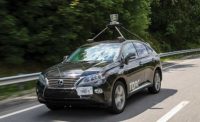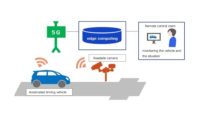While the trend of autonomous driving is also catching on in off-highway vehicles, the use cases are very different compared to on-road vehicles where the main purpose is to move from Point A to Point B on their own with help of onboard sensors and systems.
In off-highway vehicles, the components of automated driving are mainly intended for an assisted or autonomous operation and not only for the autonomous movement from one place to the next. Automation in off-highway therefore often goes beyond “automated driving” and the automation of the process requires additional efforts but sometimes even leads to higher benefits than solely automating the driving function.
“Unlike on-highway, vehicles where high levels of reusability of systems are possible and costs are therefore spread across a wide volume spectrum, off-highway has rather diverse applications and limited volumes of each application to share individualization cost of the system,” explained Gilles Mabire, Continental’s Head of the Commercial Vehicles & Services business unit.
He also noted that off-highway vehicles are subject to more hostile environments of dust, water ingress, and higher vibration levels, which means sensors must be specially designed for the extreme use cases.
“Our high-flash LiDAR contains a solid-state sensor to guarantee durability in the harsh off-highway environmental conditions,” Mabire said. “Sensors that take the specific requirements of this industry into considerations and reflect them in the design are already available. We are also testing—jointly with OEMs—these sensors in real environments.”
He said, as for now, the greatest opportunities and most developed applications are in agriculture and in restricted area environments like mining or ports.
“In general, use cases in restricted areas are the first use cases where autonomous off-highway vehicles could be found,” Mabire said. “For several years already mining equipment, especially mining trucks, have been operating autonomously.”
Mowing with autonomous machines
One area where autonomous off-highway vehicles are breaking new ground is on the links—where autonomous mowing solutions for golf and sports turf are sharing the field with athletes. John Deere first announced its intent to make automated mowers last year, showing off its first autonomous fairway mower to the industry in July, and it is currently testing the machine at various courses across the world.
“With labor costs and availability becoming increasing concerns, our golf customers are eager to embrace autonomous equipment on their golf courses,” explained John Deere product manager Brooks Hastings. “There are several industries where autonomous equipment make sense, from agriculture and construction to turf.”
Hastings said conducting tests and continuing to perfect the technology will be key to making autonomous technology a mainstream feature from fields to fairways.
“We began investing in automation 20 years ago on the agriculture side of the business, and we continue to innovate in that area today as it’s critical in providing farmers with more choices to get their jobs done in a more efficient manner,” he said. “Hundreds of thousands of highly automated John Deere farm vehicles now operate in more than 100 countries around the world.”
He explained that by automating aspects of these complicated jobs, John Deere can increase customer productivity by adding more repeatable actions to farmers’ equipment.
“This helps generate a more consistent and profitable outcome despite the significant and wide-ranging variables inherent to farming,” Hastings said. “These same learnings can be brought to the golf course.”
Demand grows as technology improves
Off-road autonomous technology has now evolved to the point where many customers—be they construction firms or agricultural businesses—are demanding advanced autonomy features, said Mike Horton, Chief Technology Officer of ACEINNA, a sensing-solution company that counts John Deere among its biggest clients.
“In the past, you would see retrofits of older tractors, but the bigger trend we see as a business is the technology becoming completely standard,” he said. “In all these environments, there are pretty significant labor shortages, so I think these capabilities pretty broadly desirable, and the technology is maturing to be able to handle lots of different kinds of missions and becoming more broadly affordable.”
He said he expects to see a lot more full autonomous vehicles in both construction and in agriculture where the ability to operate in inclement weather is among the major benefits.
“It’s been assistance systems so far, but now you see decent quantities of purpose-built autonomous machines, and that’s starting to ramp up,” he said. “There are some big announcements coming up in the area of excavation equipment, which is a pretty high-volume machine, with close to a million produced each year.”
From Norway to Brazil, opportunities abound
Sasko Cuklev, Director of Autonomous Solutions for Volvo Trucks, said the company is focusing on market segments like mining and agriculture where there are ongoing commercial implementations in each.
In the mining case, the company will be in operation this year at Brønnøy Kalk AS in Norway to provide its first commercial autonomous solution, transporting limestone from an open pit mine to a nearby port.
“There are many situations where autonomous solutions can be implemented,” Cuklev said. “We will not be able to cope with all those industries and we don’t want to be spread too thin, so we are currently focusing on three segments—mining, where we have the Norway deal; ports and logistics centers, where we facilitate transport between two hubs like between a port and a distribution center; and a third is hub-to-hub over highways.”
In the near future, Volvo’s Vera electric autonomous truck, which is controlled and monitored via a control center, will be deployed at the port of Gothenburg in Sweden through a partnership with the logistics company DFDS and APM Terminals running from a cross-dock through an industrial area to the port.
Cuklev said plans are also in the works to bring the autonomous solutions out of the port area and onto highways.
Half a world away in Brazil, Volvo has, with a local sugarcane harvesting company, commercialized a solution to help improve efficiency during harvesting.
“When you see the field in front of you, it’s difficult to see where the plantation lines are, and they have had problems where they cannot see where the field lines are, and when they do the harvesting they run over the crops for next year,” Cuklev explained. “We are using GPS and uploading maps in the vehicle so we know exactly where to drive the truck so we don’t run over next year’s crops. The driver gets support with the steering, and that’s a big productivity gain for the customer.”
While Cuklev also points out that autonomous mining solutions have been in place for some time now, it is continued real-world experience and commercial implementation that pushes companies—and the technology—forward.
“Many companies can show off a concept in a prepared environment with a safety driver, but it will be a different thing entirely to operate 24/7 over the course of a four-year contract,” he said. We have to figure out how we can make this system work every second of every day in a production-critical environment.
Robustness and reliability are the twin watchwords of such capabilities where the end-goal is increased flexibility and efficiency for customers.
“My belief is when you do it for real that you will come up with the issues you maybe didn’t think of in the beginning,” he said. “You really have to operate in a production-critical environment—that is where you will learn the most.”








